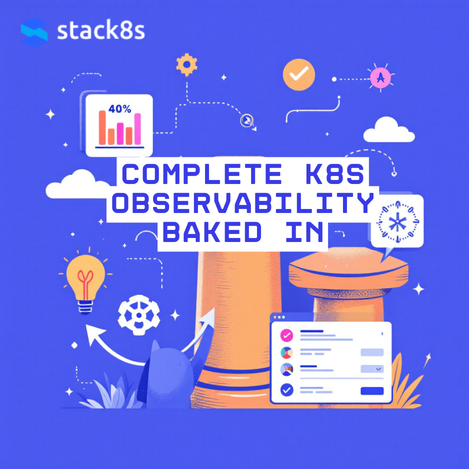Kubernetes observability is all about monitoring and understanding the performance and health of your Kubernetes clusters. By using metrics, logs, and traces, teams gain real-time insights to keep systems running efficiently and securely. This guide covers the key tools, best practices, and methods to make observability work for you.
Key Takeaways
- Kubernetes Observability helps track system health and optimize performance with metrics, logs, and traces.
- The Three Pillars: Metrics measure performance, logs record events, and traces show how requests flow between services.
- Why It’s Important: Without observability, diagnosing issues, optimizing resources, and avoiding downtime become much harder in complex Kubernetes setups.
- Top Tools: Solutions like Prometheus, Grafana, Jaeger, and the ELK Stack are popular for Kubernetes monitoring, with commercial platforms offering additional features.
- Challenges: Handling scale, managing data, and balancing costs while maintaining security and compliance are ongoing concerns.
Understanding Kubernetes Observability
Observability in Kubernetes involves collecting and analyzing data to understand how systems are performing. It lets teams catch problems early, fine-tune resources, and ensure clusters stay reliable. The goal is to turn raw data into actionable insights.
The Core of Kubernetes Observability: Metrics, Logs, and Traces
Modern Kubernetes environments produce vast amounts of data. To make sense of it, observability revolves around three main components:
- Metrics: These are numerical snapshots of performance, like CPU usage or memory consumption. Metrics help identify trends and potential bottlenecks before they escalate.
- Logs: Logs capture activity details in your system, from application errors to system events. Analyzing logs can reveal the cause of specific issues.
- Traces: Traces follow requests as they pass through multiple services, helping pinpoint latency or performance problems across microservices.
Why Observability Matters
Kubernetes environments are increasingly complex. Without observability, small issues can snowball into major downtime, impacting users and business operations. Observability ensures teams can spot and address problems before they cause disruptions.
- Proactive Management: Observability shifts teams from reacting to outages to preventing them.
- Improved Performance: By understanding usage patterns, teams can fine-tune systems for better efficiency.
- Better Resource Allocation: Observability ensures resources are used effectively, saving costs.
Building an Observability Strategy
Tools for Observability
- Prometheus and Grafana: Prometheus gathers metrics, while Grafana turns them into visual dashboards. Together, they provide clear insights into cluster performance.
- ELK Stack (Elasticsearch, Logstash, Kibana): This stack excels in log aggregation and analysis. Kibana’s dashboards make interpreting logs straightforward.
- Jaeger: Ideal for tracing, Jaeger shows how requests move across your services, identifying performance bottlenecks.
- Commercial Platforms: Paid solutions often combine metrics, logs, and traces in a single interface. They add features like AI-driven insights and automated alerts.
Best Practices for Kubernetes Observability
- Collect Metrics Everywhere: Gather data from nodes, pods, and applications to get a full picture of your cluster’s health.
- Streamline Log Management: Use a centralized system to collect and store logs. Implement retention policies to control storage costs.
- Implement Tracing: Use tracing tools to monitor how requests travel across services. Focus on latency and error rates to improve performance.
- Enable Alerting: Set up alerts for key issues like high resource usage or failed deployment events to catch problems early.
- Prioritize Data Security: Ensure observability tools comply with your organization’s security and compliance policies.
Overcoming Challenges
- Scaling Issues: As clusters grow, observability tools can become resource-intensive. Use sampling and efficient storage methods to reduce strain.
- Data Overload: High volumes of metrics and logs can overwhelm systems. Use retention policies and tiered storage to manage data effectively.
- Cost Management: Optimize resource requests and avoid over-collecting unnecessary data to keep costs in check.
Monitoring Kubernetes Effectively
Metrics Management
Use tools like Prometheus to collect metrics from all levels of your Kubernetes stack. Focus on critical areas like CPU/memory usage, pod restarts, and API response times. Combine these metrics with dashboards in Grafana for a clear view of performance.
Logs in Focus
Centralized log aggregation is essential in Kubernetes. Tools like the ELK Stack or Fluentd can process large volumes of logs, making it easier to search and analyze events. Filter logs to focus on high-priority data and reduce storage needs.
Tracing in Action
Tracing tools help monitor the flow of requests through microservices. Jaeger provides insights into latency and errors, making it easier to diagnose distributed system issues. Use automated instrumentation to collect trace data without adding much overhead.
Final Thoughts
Kubernetes observability is essential for maintaining performance, security, and reliability in today’s containerized environments. By using the right tools and following best practices, teams can turn complex data into actionable insights, ensuring their systems run smoothly and efficiently.
